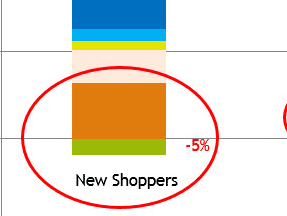Growing a successful ecommerce business may depend on earning repeat business from a relatively small number of loyal shoppers, according to a new report.
The top 1 percent of a typical ecommerce retailer’s customers will spend as much as the bottom 50 percent over time, according to the 2014 Ecommerce Benchmark Report from data analysis firm RJMetrics.
Looking beyond just the top 1 percent, an online retailer’s best customers will spend about 30 times as much as an average customer in the long run, implying that marketing strategies, at least for some online retail businesses, should be more concerned with encouraging lasting shopper relationships with high-value customers, rather than trying to attract unknown masses of new shoppers.
Loyal Customers Spend More in Two Ways
As the figures above imply, having a loyal shopper who returns time and time again, creates a much higher value customer over some number of months or years. This improved lifetime customer value is the first of at least two ways that loyal shoppers can be better for an ecommerce business than single-visit shoppers.
The second way that loyal customers can be more valuable is in average order value. Put simply, loyal shoppers don’t just spend more over time, they also spend more each time they shop.
The RJMetrics report estimated that the average order value for the bottom 90 percent of shoppers is around $54. A loyal shopper in the top ten percent of a merchant’s active customers will typically spend $163 per order, according to RJMetrics, or more than three times as much as the average shopper. Finally, a top 1 percent customer will spend about $267 per visit, which is more than five times as much as an average shopper.
This RJMetrics data released this month generally agrees with a similar study that Adobe conducted last year. In its study, The ROI of Marketing to Existing Online Customers, Adobe estimated that a returning shopper who makes a second purchase will spend about three times as much on the second visit as a single-visit shopper. Similarly, what the Adobe study described as “repeat” shoppers, who return three or more times, will generally spend about five times as much per visit as a newly acquired shopper.
Repeat Shoppers Tend to Cost Less to Service
There are also strong indications that loyal, repeat shoppers may cost less to service.
“Repeat revenue is preferable to revenue from new customers, hands down,” the RJMetrics report said. “Existing customers are cheaper to market to and the revenue is more predictable.”
To help make this point consider the relative cost of sending a targeted email to existing shoppers versus funding a pay-per-click campaign or hiring a search-engine-optimization expert. The former may cost pennies, while the latter could cost hundreds or thousands.
Implications for Ecommerce Marketing
The importance of loyal, repeat shoppers has implications for ecommerce marketing.
“Returning and repeat purchasers generate a disproportionately large share of revenue for online retailers,” Adobe said in its study. “Despite this fact, however, the majority of retail digital marketing budgets are spent on media that does not effectively target these more productive customer segments.
“Retailers can achieve tremendous revenue gains by shifting their marketing budgets to better target these customer segments,” Adobe said.
Practically speaking, this may mean that some online retailers will want to spend less on marketing tactics that aim at single-visit shopping behaviors, diverting marketing dollars to tactics capable of creating long term shopping relationships.
Specifically, this may mean investing fewer dollars and cents in SEO, which is otherwise experiencing diminishing returns in the face of rapid search engine algorithm changes and changes in user behavior; PPC; or even banner advertising.
More resources could be devoted to content marketing, growing email or text lists, developing useful mobile applications, incorporating game principles into loyalty programs, encouraging subscription shopping, remarketing, group buying, or providing better customer service, including personalization and product cross and upselling.
The particular context in which a business is operating will affect marketing strategies and tactics even where the notion of targeting long-term customers is concerned. As an example, a new ecommerce business will need to attract customers before it can engage those customers long term. Nonetheless, even a new enterprise will want to have marketing plans in place to retain shoppers from the very beginning, given that doing so may be a strong indicator of success.





